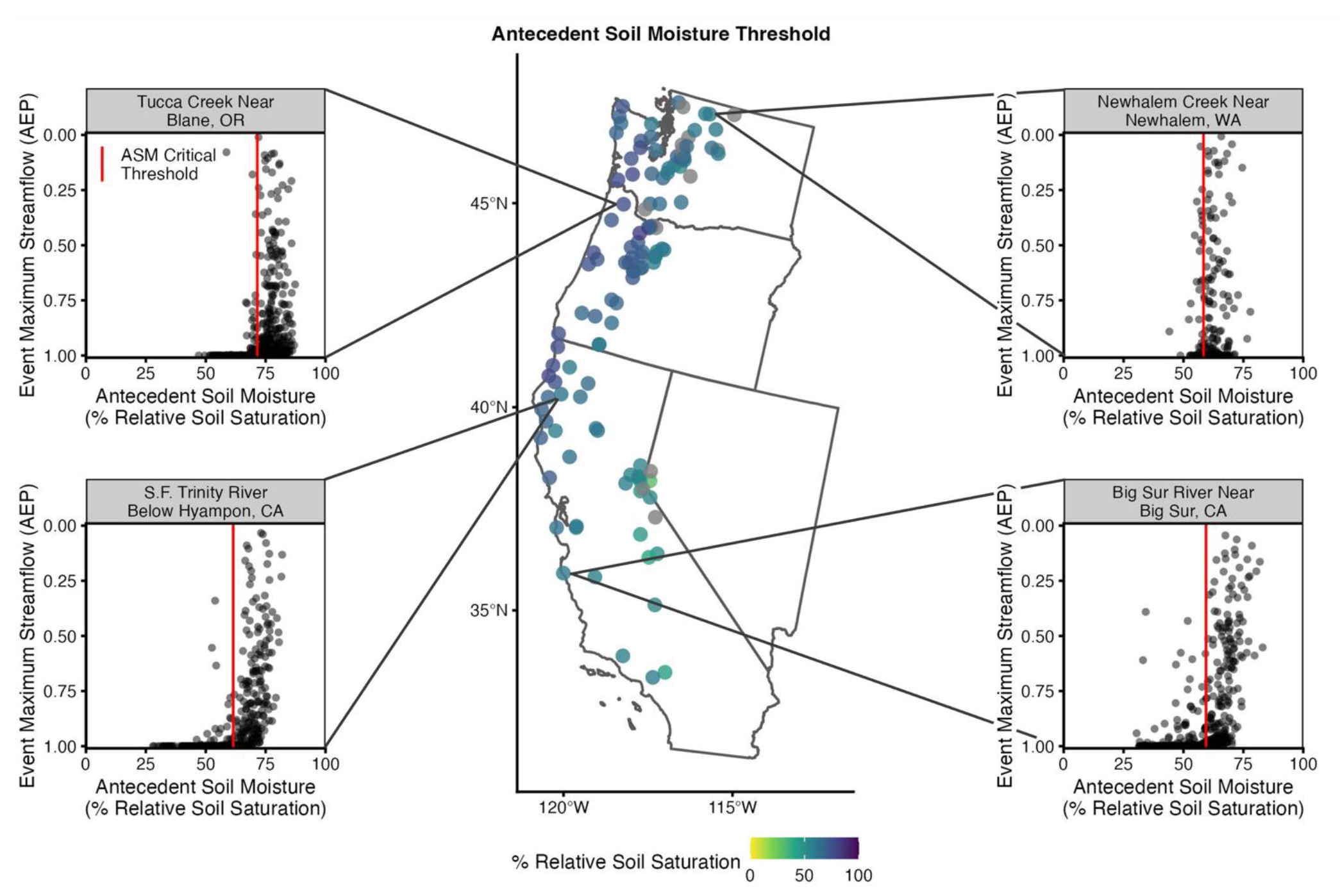CW3E Publication Notice
Wet Antecedent Soil Moisture Increases Atmospheric River Streamflow Magnitudes Non-Linearly
May 28, 2025
A new study published in the Journal of Hydrometeorology shows that wet soils significantly increase flood risk during atmospheric rivers (ARs). The paper, titled “Wet Antecedent Soil Moisture Increases Atmospheric River Streamflow Magnitudes Non-Linearly,” was led by Desert Research Institute Ph.D. candidate Mariana Webb with co-authors Christine Albano (DRI), Adrian Harpold (UNR), Daniel Wagner (USGS), and Anna Wilson (CW3E).
By analyzing more than 43,000 AR events across 122 watersheds on the U.S. West Coast between 1980 and 2023, the researchers found that peak streamflow is, on average, 2-4.5 times higher when soils are already wet compared to when they are dry. This response is non-linear, with AR-driven streamflow sharply increasing when antecedent soil moisture exceeds a watershed-specific threshold (Figure 1). Together, these findings help explain why some ARs cause catastrophic flooding while others of comparable intensity do not. Weaker ARs (AR1-2), normally considered low risk, can generate major floods if they coincide with wet antecedent conditions, while many stronger ARs (AR4-5) may not lead to flooding when conditions are dry.
The study also found that antecedent soil moisture plays a larger role in determining flood magnitude in specific physiographic and climatic settings. In regions like California and southwestern Oregon, AR-driven streamflow is highly sensitive to antecedent soil moisture. These watersheds typically have shallow, clay-rich soils, lower winter precipitation, and higher evaporation, leading to limited hydrologic storage capacity and more variable soil moisture between storms. In contrast, in Washington and the interior Cascades and Sierra Nevada, watersheds tend to have deeper soils, snowpack, and consistently wet winter conditions, which increase storage capacity and reduce soil moisture variability. While antecedent soil moisture still can play a role, it provides less added value for flood prediction in these regions because soils are often consistently wet or insulated by snow.
Tailoring flood risk evaluations to a specific watershed’s physiography and climate characteristics could improve flood-risk predictions. Because AR-driven streamflow varies not just with storm intensity but also with antecedent soil moisture, the study highlights the value of integrating land surface conditions into AR impact assessments. The strong alignment between each watershed’s antecedent soil moisture threshold and its average winter soil moisture opens the door to using seasonal soil moisture averages as a practical proxy for identifying heightened flood potential—simplifying implementation in flood forecasting models and early warning systems. The study further highlights the importance of prioritizing watersheds where antecedent soil moisture has a greater influence on flood response, such as those with limited storage and high variability in soil moisture. Increased monitoring in these high-risk catchments, including real-time soil moisture observations, could significantly enhance early warning systems and flood management as AR frequency and intensity continue to evolve with climate change.
To read more about this study access the entire publication here.
Figure 1. Map showing the antecedent soil moisture threshold, above which event maximum streamflows are larger, at each watershed. Watersheds with no statistically significant (p-value <0.05) threshold value (n=14) are shown in grey. Inset scatterplots show individual maximum streamflows for atmospheric river (AR) events as a function of the associated ASM for four watersheds. The vertical red line indicates the location of the calculated ASM threshold. (Figure 4 from Webb et al. (2025))
Webb, M. J., Albano, C. M., Harpold, A. A., Wagner, D. M., & Wilson, A. M. (2025). Wet Antecedent Soil Moisture Increases Atmospheric River Streamflow Magnitudes Non-Linearly. Journal of Hydrometeorology., https://doi.org/10.1175/JHM-D-24-0078.1.

